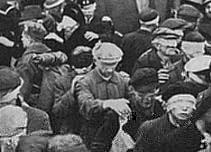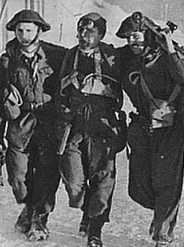|
OVERVIEW
The word ‘commando’ today conjures up many images of small bands of elite
soldiers carrying out raids deep behind enemy lines. Much of this
comes from some of the first operations carried out by British and allied
‘commandos’ during WWII in Norway.
The term ‘commando’ itself
came from the Boer war in South Africa from 1899-1902 where bands of irregular
Boers called ‘commandos’ would strike swiftly and suddenly at the
British army.
This then was the name
to be given to the new force of volunteers being formed in 1940 after Winston
Churchill had decreed that Britain must be able to strike back at the Germans
so as to keep up morale, tie down German forces and to foster an offensive
spirit into an army and people who were staring into the face of an invasion.
This article gives a brief description of the commando raids conducted
in Norway by the British and Norwegian commandos during WWII. |
 |
Operation
Claymore
DATE: 04.03.41
LOCATION: Lofoten Islands (Svolvær,Stamsund)
UNIT(S): 3,4 Cdos & a party
of Norwegians
NUMBERS: 800
 |
DESCRIPTION:
One of the very first commando operations. The targets were a number of
fish oil factories which produced glycerine for use in munitions. The mission
was a complete success with very little fighting taking place and the targets
destroyed. The force returned with 315 volunteers for the Norwegian forces,
60 ‘Quisling’ collaborators and 225 German prisoners. |
| The only casualty was
a British officer who accidently shot himself in the thigh. In adition
some parts to an ‘enigma’ code machine were captured which helped the code-breakers
of Bletchley park a great deal. One humorous incident which took place
was the sending of a telegram from Stamsund addressed to A.Hitler,Berlin,
it said: ‘you said in your last speech German troops would meet the British
wherever they landed. Where are your troops?’ |
 Prisoners from
Prisoners from
Operation Claymore
|
Operation
Gauntlet
DATE: 24.08-02.09.41
LOCATION: Spitzbergen (Svalbard)
& Bear Island
UNIT(S): Canadians and others
NUMBERS: 1,500
| DESCRIPTION:
Whilst not strictly a commando operation as the participating troops where
Canadian soldiers who had been trained in amphibious warfare. This operation
was aimed at destroying the coalmines on Svalbard to prevent them falling
into German hands, to evacuate 2,000 Soviet miners to Archangel in Northern
Russia and some 800 Norwegians to Great Britain. The radio and weather
installation on Bear Island (Bjørnøya) was also destoyed
and the people there evacuated. |

Not only the mines on
Svalbard
that had to be destroyed,
this
picture shows the radiostation
in
Barentsburg being blown
up.
|
Operation
Anklet
DATE: 26-28.12.41
LOCATION: Lofoten Islands ( Reine,
Sund & Sørvågen)
UNIT(S): 12 Cdo, ‘Linge’ company
NUMBERS: 300
DESCRIPTION: This operation
was in fact designed as a diversion for Operation Archery described below.
The force which included men from the Norwegian ‘Lingekompaniet’ landed
unopposed and captured the German garrison without a fight, they left two
days later after having destroyed installations and taking with them 29
German prisoners as well as over 200 Norwegians.
Operation
Archery
DATE: 27.12.41
LOCATION: Vågsøy
UNIT(S): 2,3,4,6 Cdos & ‘Linge’
company
NUMBERS: 800 (including
36 Norwegians)
DESCRIPTION: This operation
is one of the most well known and certainly the best photographed as the
raid was accompanied by official photographers and cameramen. The raid
was to destroy German installations at Vågsøy and the force
was to be supported by the RAF who provided air cover and attacked the
airfield of Herdla near Bergen. The naval part of the force consisted of
one cruiser, four destroyers and two landingships, the warships opened
the proceedings with a bombardment of the island of Måløy.
| The commandos were split
into five groups, one landed to the West of South Vågsøy to
secure the area then move up to the town. The second group landed to the
North of the town to prevent German reinforcements getting in. The third
group landed on Måløy to deal with the guns and garrison there
however the navy had done their job well and the guns were silent, it didn’t
take long for the garrison to be subdued. The fourth group landed at the
town itself and this proved to be the main center of resistance. The last
group was kept onboard ship to act as a floating reserve. |

Wounded commando
|
The Germans in the town were in greater numbers than expected and the group
there called for reinforcements from the group to the West, from the floating
reserve and from elements of the group on Måløy.
 |
Fierce House to house
fighting developed but by 13:45 the fighting was over and an hour later
the force re-embarked. Behind them they left 15,000 tons of shipping destroyed,
warehouses, dockyards, fish-oil processing plants and all German installations
destroyed.
98 Germans were taken
prisoner along with 4 ‘Quislings’, 77 Norwegians also decided to come with
them back to Britain. |
The cost to the Germans had
been around 150 killed, the British lost 19 men and 57 wounded and the
Norwegian force lost 1 man and 2 wounded. The Norwegian killed was an especially
painful loss as it was their commander Kaptein Martin Linge who fell during
the assault on Måløy.
The after effects of the raid had far reaching consequences, the Germans
took reprisals against the Norwegian population which prompted protests
from the Norwegian king Haakon VII and the government-in-exile. The Germans
also began to reinforce and strengthen their defences which was to the
allies advantage as this tied down many troops which could otherwise be
used elsewhere.
Operation
Musketoon
DATE: Night 20-21.09.42
LOCATION: Glomfjord
UNIT(S): 2 Cdo
NUMBERS: 12
DESCRIPTION: This operation
was given the task of destroying the power station in Glomfjord which was
providing power to an aluminium plant in the area. Captains Black and Houghton
along with 8 other ranks and 2 Norwegians set off from Scotland onboard
a Free French submarine on the 11th Sept. Arriving 4 days later they then
had a 3 day approach march over the mountains to the target arriving on
the 18th, they decided to attack the objective on during the night of the
20th-21st. Complete surprise was achieved, however as the party withdrew
and the charges were going up they encountered Germans which forced them
to split up. In the confusion one of the British was killed, one of the
Norwegians mortally wounded and the two officers wounded, they along with
four others were captured however the other Norwegian and three of the
British managed to make their way into Sweden and eventually on to Britain
individually. As for the prisoners, the two officers were to become the
first to suffer under Hitlers infamous ‘Commando order’ by being shot by
firing squad.
Operation
Freshman
DATE: Night 19-20.11.42
LOCATION: Vemork
UNIT(S): Royal Engineers
NUMBERS: 32
DESCRIPTION: The famous attack
on the heavy water plant at Vermok will be discussed in greater detail
in another article.
Operation
Cartoon
DATE: Night 23-24.01.43
LOCATION: Stord
UNIT(S): 10,12 Cdos
NUMBERS: 63
DESCRIPTION: A complete success,
this operation’s aim was to destroy the pyrite mine on the island of Stord
near Leirvik. Members of 12 Cdo were accompanied by 10 men from the Norwegian
troop of 10 (IA) Cdo under Captain Harald Risnes, 7 MTB’s of the 30th (Royal
Norwegian Navy) MTB flottila were used as transport. Half the force were
landed at Sagvåg quay and engaged the defending German positions
there whilst the remainder were landed on the other side of the bay. The
mine which was 2 miles away was reached in 25 minutes by the men who were
carrying 50lbs of explosives each. The charges were set and the mine put
out of action for a year. Meanwhile 3 of the MTB’s went on to Leirvik in
search of shipping but found none. However on the way back a ship was attacked
and left in a sinking condition, mines were also laid. The raid netted
3 German prisoners as well as a quantity of papers and equipment, this
was achieved for the loss of 1 commando killed, 2 commando’s and 8 sailors
injured.
Operation
Crackers
DATE: 24.02-01.03.43
LOCATION: Sognefjord
UNIT(S): 10,12,30 Cdos
NUMBERS: 16
DESCRIPTION: The original
object of this operation was to attack an observation post and take a look
at another, rough seas prevented this, so instead an observation post was
manned for a week undetected, gathering information.
Operation
Brandy
DATE: Night 14-15.02.43
LOCATION: Floroe
UNIT(S): 10,12 Cdos
NUMBERS: 7
DESCRIPTION: This was a Norwegian
operation with Lieutenant Rommetveldt who commanded the Norwegian commandos,
taking 6 of his men aboard two Norwegian MTB’s (motor torpedo boats) for
an operation into Florø harbour. 2 German ships were torpedoed and
a third struck a mine laid by the MTB’s. One of the MTB’s ran aground and
had to be abandoned.
Operation
Checkmate
DATE: 29.04.43
LOCATION: Haugesund
UNIT(S): 14 Cdo
NUMBERS: 6
DESCRIPTION: Attempted attack
on shipping at Haugesund. 4 attempts to pick up the party failed due to
bad weather and no trace of them was found. One ship may have been attacked.
*
OTHER OPERATIONS
Numerous other operations
were planned, trained for and begun before being called off for many different
reasons ranging from Weather to long daylight hours in the summer and from
bad luck to bad planning. It must also be mentioned that the SOE (Special
Operations Executive) which had responsibility for conducting espionage,
sabotage and liason with local resistance groups were heavily involved
in planning and coordinating the raids carried out after Archery .
10 (Inter-Allied) COMMANDO
This special unit formed
in June 1942 consisted of troops from the occupied countries. Each troop
initially would consist of 4 officers and 83 other ranks. Countries represented
included France, the Netherlands, Belgium, Poland, Yugoslavia and of course
Norway whose troop became No.5 (Norwegian) Troop. A ‘miscellaneous’ troop
was also created with members coming from the axis countries such as Germany
and Austria.
*
*
Simon Orchard is
a major contributor to NDWW2
*
All pictures is official
pictures, if anyone owns the copyrights to these, e-mail
me asap, and I will remove them.
|


